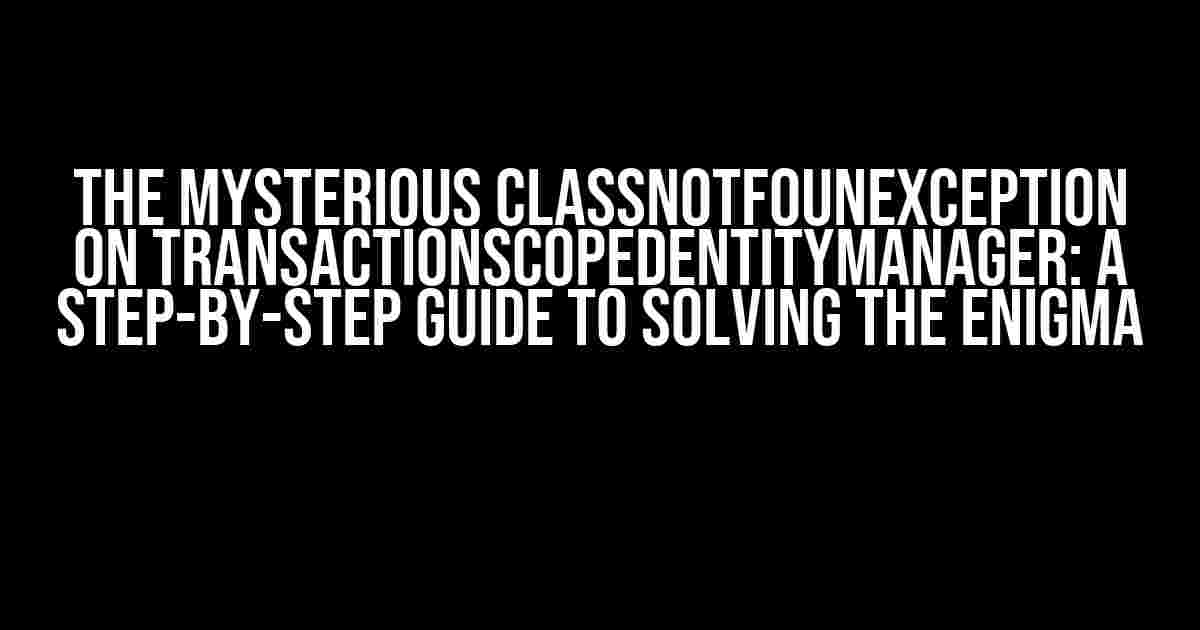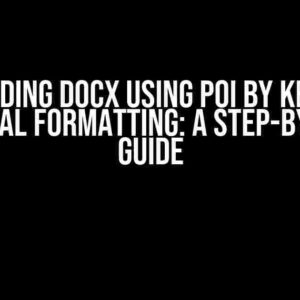Have you ever encountered the dreaded ClassNotFounException on TransactionScopedEntityManager after a database persist? Don’t worry, you’re not alone! This frustrating exception can leave even the most seasoned developers scratching their heads. But fear not, dear reader, for we’re about to embark on a thrilling adventure to conquer this pesky issue once and for all.
What is the ClassNotFounException?
The ClassNotFounException is a runtime exception that occurs when the Java Virtual Machine (JVM) or a ClassLoader instance tries to load a class that doesn’t exist or can’t be found. In the context of TransactionScopedEntityManager, this exception usually arises when the entity manager is unable to locate a specific class required for the transaction.
Symptoms of the ClassNotFounException
Before we dive into the solutions, let’s identify the common symptoms of this exception:
- The application fails to persist data to the database.
- The TransactionScopedEntityManager throws a ClassNotFounException.
- The error message indicates that a specific class cannot be found.
- The application may crash or hang indefinitely.
Causes of the ClassNotFounException
Now that we’ve got a better understanding of the symptoms, let’s explore the common causes of this exception:
1. Missing Dependencies
One of the most common causes of the ClassNotFounException is missing dependencies in the project’s classpath. This can occur when:
- JAR files are missing or corrupted.
- The project’s classpath is not properly configured.
- dependent libraries are not correctly included in the project.
2. Incorrect Class Path
Another common cause is an incorrect class path. This can happen when:
- The class path is not correctly set in the project’s configuration files.
- The class loader is not properly configured.
- The application server’s class path is not correctly set.
3. Class Loading Issues
Class loading issues can also lead to the ClassNotFounException. This can occur when:
- Multiple class loaders are used, causing conflicts.
- The class loader is not correctly configured to load the required classes.
- There are version conflicts between different class versions.
Step-by-Step Solutions
Now that we’ve identified the causes, let’s dive into the step-by-step solutions to resolve the ClassNotFounException:
Step 1: Verify Dependencies
Ensure that all required dependencies are present in the project’s classpath. Check the project’s configuration files (e.g., pom.xml, build.gradle) to ensure that all necessary JAR files are included.
<dependencies>
<dependency>
<groupId>javax.persistence</groupId>
<artifactId>javax.persistence-api</artifactId>
<version>2.2</version>
</dependency>
</dependencies>
Step 2: Check Class Path
Verify that the class path is correctly set in the project’s configuration files. Ensure that the class path includes all necessary directories and JAR files.
<classpath> <pathelement location="/path/to/dependency/JAR"/> <pathelement location="/path/to/another/dependency/JAR"/> </classpath>
Step 3: Configure Class Loader
Ensure that the class loader is correctly configured to load the required classes. This may involve setting the class loader’s parent class loader or specifying the order of class loading.
<classpath> <pathelement location="/path/to/dependency/JAR"/> <pathelement location="/path/to/another/dependency/JAR"/> <param name="parentClassLoader" value="true"/> </classpath>
Step 4: Resolve Class Loading Issues
Address any class loading issues by:
- Ensuring that only one class loader is used.
- Configuring the class loader to load classes in the correct order.
- Resolving version conflicts between different class versions.
Step 5: Verify Entity Manager Configuration
Ensure that the entity manager is correctly configured to use the TransactionScopedEntityManager. Verify that the persistence unit is correctly defined and that the entity manager is properly injected.
<persistence-unit name="myPU" transaction-type="RESOURCE_LOCAL">
<provider>org.hibernate.jpa.HibernatePersistenceProvider</provider>
<jta-data-source>jdbc/myDS</jta-data-source>
<properties>
<property name="javax.persistence.jdbc.url" value="jdbc:mysql://localhost:3306/myDB"/>
<property name="javax.persistence.jdbc.user" value="myUser"/>
<property name="javax.persistence.jdbc.password" value="myPassword"/>
</properties>
</persistence-unit>
Conclusion
In conclusion, the ClassNotFounException on TransactionScopedEntityManager can be a frustrating issue, but with the right approach, it can be resolved. By following the step-by-step solutions outlined in this article, you’ll be able to identify and fix the underlying causes of this exception. Remember to verify dependencies, check the class path, configure the class loader, resolve class loading issues, and verify the entity manager configuration. With patience and persistence, you’ll be able to overcome this obstacle and get your application back on track.
Additional Resources
For further reading and troubleshooting, we recommend the following resources:
- Java SE API Documentation: https://docs.oracle.com/javase/8/docs/api/
- Java Persistence API Documentation: https://javaee.github.io/javaee-spec/javadocs/
- Stack Overflow: https://stackoverflow.com/questions/tagged/classnotfoundexception
| Keyword | Definition |
|---|---|
| ClassNotFounException | A runtime exception that occurs when the JVM or a ClassLoader instance tries to load a class that doesn’t exist or can’t be found. |
| TransactionScopedEntityManager | A type of entity manager that provides transactional scope for database operations. |
| Dependency | A library or JAR file required by a project to function correctly. |
| Class Path | The path where the JVM searches for classes and resources. |
| Class Loader | A component that loads classes and resources into the JVM. |
We hope this article has been helpful in resolving the ClassNotFounException on TransactionScopedEntityManager. If you have any further questions or need additional assistance, please don’t hesitate to ask in the comments below.
Frequently Asked Question
Get ready to solve the mystery of the “ClassNotFounException on TransactionScopedEntityManager after a database persist”!
What is this sorcery? Why do I get a ClassNotFounException on TransactionScopedEntityManager after a database persist?
Don’t worry, it’s not magic (unfortunately)! This exception usually occurs when the entity manager is not properly configured or when there’s a mismatch between the persistence unit and the entity classes. Make sure to check your persistence.xml file, entity classes, and their corresponding annotations.
Is it related to the transaction scope or is it a configuration issue?
More often than not, it’s a configuration issue! The TransactionScopedEntityManager relies on the proper configuration of the persistence unit and the entity manager. Double-check your configuration files, annotations, and dependencies to ensure everything is in order. If you’re still stuck, try debugging your application to identify the root cause.
What are some common mistakes that can lead to this exception?
Ahah, good question! Some common mistakes include: missing or incorrect entity annotations, incorrect package names, incorrect persistence unit naming, and missing dependencies. Make sure to review your code and configuration files carefully to avoid these common pitfalls!
How can I troubleshoot this issue?
Troubleshooting 101! Enable debug logging, review the server logs, and check the entity manager’s configuration. You can also try debugging your application step-by-step to identify where the issue arises. If you’re still stuck, try searching for similar issues online or seeking help from a fellow developer.
Can I prevent this exception from occurring in the first place?
Prevention is the best medicine! To avoid this exception, ensure you follow best practices when configuring your persistence unit and entity manager. Use a consistent naming convention, verify your entity annotations, and double-check your dependencies. By being diligent in your configuration and coding, you can reduce the likelihood of this exception occurring.


